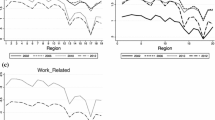Summary and Conclusions
This study takes as its starting point the hypothesis that demographic characteristics of households are as relevant determinants of the pattern of consumer expenditures in the United States as are measured prices and incomes. Demographic characteristics of households are brought to bear upon their expenditure patterns not via their impact on consumer tastes but rather via their effect on “true” prices and “permanent” incomes faced by households.
The Bureau of Labor Statistics' 1972/73 Consumer Expenditure Survey data are used to estimate several expenditure functions. The econometric results unequivocally demonstrate the validity of the authors' hypothesis. Various demographic factors such as the age of the household head, his/her educational attainment, the employment status of the household head and spouse, the household's race and region of location are all found to be significant determinants of the pattern of expenditures in the United States.
Similar content being viewed by others
References
G. S. Becker, “A Theory of the Allocation of Time,”Economic Journal, Vol. 75, September 1965, pp. 493–517.
__,Economic Theory, New York: Alfred A. Knopf, 1971.
__ and G. J. Stigler, “De Gustibus Non Est Disputandum,”American Economic Review, Vol. 67, No. 2, March 1977, pp. 76–90.
N. Bhattacharya and B. Mahalanobis, “Regional Disparities in Household Consumption in India,”Journal of American Statistical Association, Vol. 62, March 1967, pp. 143–161.
R. L. Clark and J. J. Spengler,The Economics of Individual and Population Aging, New York: Cambridge University Press, 1980.
B. Cooper and P. A. Piro, “Age Differences in Medical Care Spending, Fiscal Year 1973,”Social Security Bulletin, Vol. 37, No. 5, May 1974, pp. 3–14.
T. J. Espenshade, “How a Trend Towards a Stationary Population Affects Consumer Demand,”Population Studies, Vol. 32, No. 1, March 1978, pp. 147–158.
M. Friedman,A Theory of the Consumption Function, Princeton, N.J.: Princeton University Press, 1957.
W. J. Gillen and A. Guccione, “The Estimation of Postwar Regional Consumption Function in Canada,”Canadian Journal of Economics, Vol. 3, May 1970, pp. 276–90.
H. S. Houthakker and L. D. Taylor,Consumer Demand in the United States: Analysis and Projections, Cambridge, Massachusetts: Harvard University Press, 1970.
K. S. Palda, “Comparison of Consumer Expenditures in Quebec and Ontario,”Canadian Journal of Economics and Political Science, Vol. 33, February 1967, pp. 16–26.
R. A. Pollak and T. J. Wales, “Estimation of Complete Demand Systems from Household Budget Data,”American Economic Review, Vol. 68, No. 3, June 1978, pp. 348–59.
S. J. Prais and H. S. Houthakker,The Analysis of Family Budgets, Cambridge University Press, 1955.
T. W. Schultz, “The High Value of Human Time: Population Equilibrium,”Journal of Political Economy, Vol. 82, March/April 1974, Supplement, pp. S2-S10.
E. Smolensky and J. Van der Gaag, “Income, Consumption, True Household Equivalence Scales and Characteristics of the Poor in the United States,” Paper presented at the World Meeting of the Econometric Society, Aix-en-Provence, September 1980.
Myra H. Strober, “Wives' Labor Force Behavior and Family Consumption Patterns,”American Economic Review (Papers and Proceedings of the 89th Annual Meeting of AEA), Vol. 67, No. 1, February 1977, pp. 410–17.
U. S. Department of Labor,Consumer Expenditure Survey: Interview Survey, 1972–73. Vol. 2: Regional Tables, Washington, D.C., 1978, Bureau of Labor Statistics.
C. Vickery, “Women's Economic Contribution to the Family,” inThe Subtle Revolution, Ralph E. Smith (editor), Washington, D.C., The Urban Institute, 1979.
Robert Willis, “A New Approach to the Economic Theory of Fertility,”Journal of Political Economy, Vol. 81, March/April 1973, Supplement: S14-S65.
A. Zellner, “An Efficient Method of Estimating Seemingly Unrelated Regressions and Tests for Aggregation Bias,”Journal of the American Statistical Association, Vol. 57, No. 298, June 1962, pp. 348–68.
Author information
Authors and Affiliations
Additional information
An earlier version of this paper was presented at the 1979 Annual Meeting of the Atlantic Economic Society, October 10–12, 1979, Washington, D.C. The authors would like to thank Mr. Lee Grimes of the Computer Center at Tennessee Tech for many hours of patient help.
Rights and permissions
About this article
Cite this article
Ketkar, S.L., Cho, W. Demographic factors and the pattern of household expenditures in the United States. Atlantic Economic Journal 10, 16–27 (1982). https://doi.org/10.1007/BF02300157
Issue Date:
DOI: https://doi.org/10.1007/BF02300157




